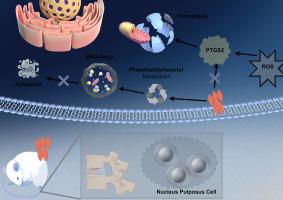Lycium barbarum alleviates oxidative stress-induced ferroptosis and enhances mitophagy in intervertebral disc degeneration
IF 3.7
2区 生物学
Q2 CELL BIOLOGY
引用次数: 0
Abstract
Lycium barbarum is a traditional Chinese medicine that has been demonstrated to exhibit a wide variety of biological functions, such as antioxidation, neuroprotection, and immune modulation. The therapeutic effect of Lycium barbarum on intervertebral disc degeneration (IVDD) has not been conclusively established. In our study, we investigated the mechanisms of Lycium barbarum extract (LBE) using Network pharmacology and bioinformatic analyses. In vitro experiments, the levels of ferroptosis were assessed using Western blot analysis and detection kits for MDA, Ferric iron and GSH. Transmission electron microscopy and Mitotracker were used to detect mitochondrial morphology. Immunofluorescence and Western blot were employed to detect the levels of mitophagy and lysosomal permeability. In vivo experiments, X-ray imaging, morphological staining, and immunohistochemical staining were used to assess the degree of intervertebral disc degeneration. As a result of the intersection between target genes of complex compounds and disease-related genes, 61 overlapping genes were identified, with PTGS2 ranking as the top overlapping gene. Molecular docking revealed that six compounds were highly stable in the Cys41 active site pocket of PTGS2. Moreover, LBE exhibited potential therapeutic effects through inhibiting mitochondrial dysfunction and ferroptosis. Besides, LBE can reduce lysosomal membrane permeability and enhance mitophagy caused by oxidative stress via regulating phosphatidylinositol metabolism. The administration of LBE in vivo can effectively slow the progression of intervertebral disc degeneration. The findings of this study suggest that LBE exhibits maybe a potential therapeutic candidate for intervertebral disc degeneration.

枸杞减轻氧化应激诱导的铁下垂,促进椎间盘退变的线粒体自噬。
枸杞是一种传统的中药,已被证明具有多种生物功能,如抗氧化、神经保护和免疫调节。枸杞对椎间盘退变(IVDD)的治疗作用尚未得到确切的证实。本研究采用网络药理学和生物信息学方法对枸杞提取物(LBE)的作用机制进行了研究。体外实验采用Western blot分析及MDA、铁和GSH检测试剂盒检测大鼠铁下垂水平。透射电镜和Mitotracker检测线粒体形态。免疫荧光法和Western blot法检测线粒体自噬水平和溶酶体通透性。体内实验采用x线影像学、形态染色、免疫组化染色评估椎间盘退变程度。由于复杂化合物靶基因与疾病相关基因的交叉,共鉴定出61个重叠基因,其中PTGS2是重叠最多的基因。分子对接发现6个化合物在PTGS2的Cys41活性位点口袋中高度稳定。此外,LBE通过抑制线粒体功能障碍和铁下垂显示出潜在的治疗作用。此外,LBE还能通过调节磷脂酰肌醇代谢,降低溶酶体膜通透性,增强氧化应激引起的线粒体自噬。体内给药LBE可以有效减缓椎间盘退变的进展。本研究结果表明,LBE可能是椎间盘退变的潜在治疗候选者。
本文章由计算机程序翻译,如有差异,请以英文原文为准。
求助全文
约1分钟内获得全文
求助全文
来源期刊

Cellular signalling
生物-细胞生物学
CiteScore
8.40
自引率
0.00%
发文量
250
审稿时长
27 days
期刊介绍:
Cellular Signalling publishes original research describing fundamental and clinical findings on the mechanisms, actions and structural components of cellular signalling systems in vitro and in vivo.
Cellular Signalling aims at full length research papers defining signalling systems ranging from microorganisms to cells, tissues and higher organisms.
 求助内容:
求助内容: 应助结果提醒方式:
应助结果提醒方式:


